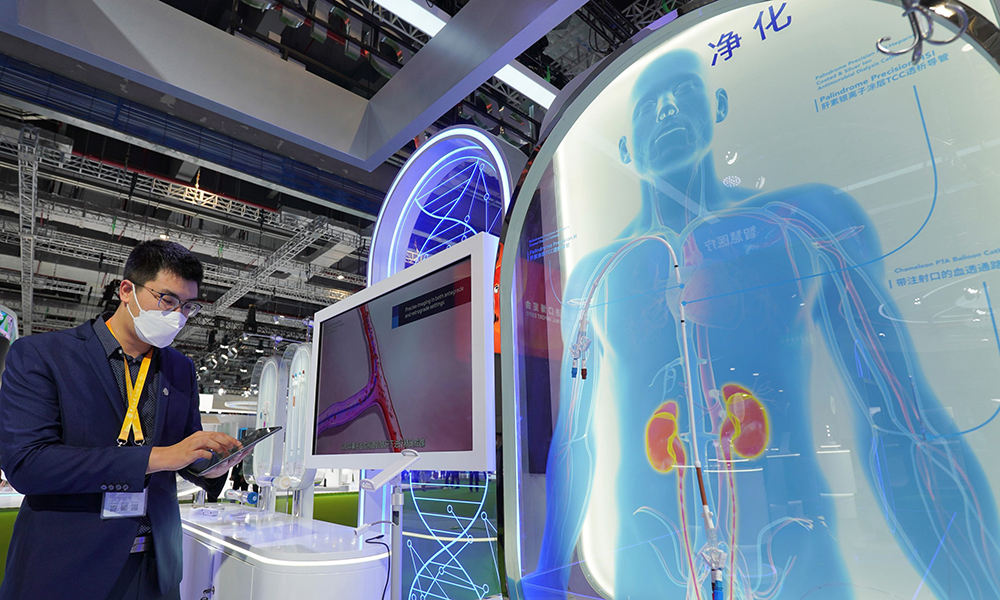
医疗器械制造商美敦力(Medtronic)的高管表示,该公司非常看好生成式人工智能的应用前景,因此公司要求每个部门研究如何利用这项技术提高生产率,或者改善患者的治疗效果。
美敦力高级副总裁兼首席技术与创新官肯·华盛顿表示,迄今为止,该公司共收到200多项创意,其中多项创意已经获得了首轮内部融资。广泛收集各种想法,对于公司的文化创造也至关重要。美敦力希望生成式人工智能成为每个人工作的重要组成部分。华盛顿表示,如果只有少数几个人工智能专家有能力为公司开发解决方案,这算不上成功。
在《财富》杂志与埃森哲(Accenture)联合举办的人工智能头脑风暴虚拟讨论会上,华盛顿在发言时表示:“我们每年服务7,400多万名患者。这相当于每秒钟有两名患者会用到这项新技术。”
美敦力已经向员工提供的生成式人工智能技术包括微软(Microsoft)365 Copilot和ChatGPT的内部版本MedtronicGPT聊天机器人。除了针对员工的生产力工具以外,美敦力还优先开展有助于改善患者治疗结果的人工智能投资,包括在结肠镜检查时,使用人工智能提升解读医学扫描结果以发现息肉的能力,或者减少心脏监测器的误报等。
华盛顿表示:“这些结果得益于人工智能在医疗手段和医疗器械方面的应用,可以改变患者的治疗结果,改善患者和临床医生的生活质量。而且我们才刚刚起步。”
埃森哲估计,有90%的公司正在探索生成式人工智能或人工智能能力,但其中只有不到三分之一的公司所培养的能力,为它们的成功奠定了基础,例如美敦力创建的人工智能卓越中心,或者以结构化的方式开发用例等。埃森哲集团首席策略官穆齐特·阿什拉夫也在虚拟讨论会上发表了演讲。他表示,只有不到20%的公司在人工智能领域的投资,正在接近它们希望实现的目标价值。
阿什拉夫说道:“当前普遍的做法更像是拿着锤子找钉子。人们思考的问题是:‘人工智能能为我做些什么?’然后去寻找一系列不同的用例。”
加州政府正在使用人工智能,改善员工的工作流程,同时改善该州近4,000万居民的生活。例如,加州机动车管理局使用人工智能驱动的聊天机器人分类处理用户请求;加州政府与加州大学圣迭戈分校(University of California, San Diego)合作开发的一个项目训练人工智能,以检测烟雾和帮助预防森林火灾。
加州首席信息官、加州科技部主任利阿纳·贝利-克利明思表示:“我们在评估任何技术时,不仅要看它能带来的经济效益,还需要评估它对人的影响[投资回报],以及是否符合政策规定。”贝利-克利明思也参加了虚拟讨论会。
她表示,加州还在与市场上的众多人工智能技术提供商合作,邀请各公司向州政府提交解决方案,包括解决交通拥堵、应对气候变化或者改善施工项目时间决策等。
她表示,她愿意采用任何有助于解决问题的技术,她还表示较为传统的人工智能和其他新兴技术可能更适合解决加州所面临的一些问题。她说道:“或许生成式人工智能并非解决方案。”
来自巴西的Natura公司(Natura & Co)生产个护和化妆品,该公司将人工智能用例分为两大类。一类是日常人工智能,旨在提高员工的工作效率。该公司首席信息官雷纳塔·马奎斯表示,另一类则是“颠覆性人工智能”,是能对生产、客户和环境产生积极影响的宏观进步。
马奎斯将对生成式人工智能的兴奋心情比作冰山。冰山的一角是技术,但在水面以下,公司需要解决数据使用、工程设计、治理和策略等方面的问题。
马奎斯说道:“我们的工作是邀请那些不理解问题复杂性和维度的人们,并与他们合作。”
Natura还非常重视对人工智能技术的投资进行衡量,包括公司希望实现的目标和想要获得的结果。马奎斯说道:“如果没有产生商业成果,那是在实验室里做的工作。而我们并不是一家实验室。”
埃森哲表示,随着人工智能技术的持续发展,公司不应该忽视这样一个事实,那就是技术成本仅占人工智能支出的约30%。剩余70%的支出被用于培训、招聘以及支持新人工智能应用所需要的变化管理。
以美敦力为例。该公司在一个内部培训项目中投入了大量精力,向员工介绍人工智能技术的可能性和局限性。华盛顿表示,虽然人工智能是一项热门技术,但关键在于“明确这项技术到底是什么,以及它对你的公司意味着什么。”
埃森哲的阿什拉夫表示:“关键不只在于技术本身,公司的转型同样重要。只有重新构想或重塑职能部门、工作流程或工作方式,才能真正释放人工智能的价值。”(财富中文网)
译者:刘进龙
审校:汪皓
医疗器械制造商美敦力(Medtronic)的高管表示,该公司非常看好生成式人工智能的应用前景,因此公司要求每个部门研究如何利用这项技术提高生产率,或者改善患者的治疗效果。
美敦力高级副总裁兼首席技术与创新官肯·华盛顿表示,迄今为止,该公司共收到200多项创意,其中多项创意已经获得了首轮内部融资。广泛收集各种想法,对于公司的文化创造也至关重要。美敦力希望生成式人工智能成为每个人工作的重要组成部分。华盛顿表示,如果只有少数几个人工智能专家有能力为公司开发解决方案,这算不上成功。
在《财富》杂志与埃森哲(Accenture)联合举办的人工智能头脑风暴虚拟讨论会上,华盛顿在发言时表示:“我们每年服务7,400多万名患者。这相当于每秒钟有两名患者会用到这项新技术。”
美敦力已经向员工提供的生成式人工智能技术包括微软(Microsoft)365 Copilot和ChatGPT的内部版本MedtronicGPT聊天机器人。除了针对员工的生产力工具以外,美敦力还优先开展有助于改善患者治疗结果的人工智能投资,包括在结肠镜检查时,使用人工智能提升解读医学扫描结果以发现息肉的能力,或者减少心脏监测器的误报等。
华盛顿表示:“这些结果得益于人工智能在医疗手段和医疗器械方面的应用,可以改变患者的治疗结果,改善患者和临床医生的生活质量。而且我们才刚刚起步。”
埃森哲估计,有90%的公司正在探索生成式人工智能或人工智能能力,但其中只有不到三分之一的公司所培养的能力,为它们的成功奠定了基础,例如美敦力创建的人工智能卓越中心,或者以结构化的方式开发用例等。埃森哲集团首席策略官穆齐特·阿什拉夫也在虚拟讨论会上发表了演讲。他表示,只有不到20%的公司在人工智能领域的投资,正在接近它们希望实现的目标价值。
阿什拉夫说道:“当前普遍的做法更像是拿着锤子找钉子。人们思考的问题是:‘人工智能能为我做些什么?’然后去寻找一系列不同的用例。”
加州政府正在使用人工智能,改善员工的工作流程,同时改善该州近4,000万居民的生活。例如,加州机动车管理局使用人工智能驱动的聊天机器人分类处理用户请求;加州政府与加州大学圣迭戈分校(University of California, San Diego)合作开发的一个项目训练人工智能,以检测烟雾和帮助预防森林火灾。
加州首席信息官、加州科技部主任利阿纳·贝利-克利明思表示:“我们在评估任何技术时,不仅要看它能带来的经济效益,还需要评估它对人的影响[投资回报],以及是否符合政策规定。”贝利-克利明思也参加了虚拟讨论会。
她表示,加州还在与市场上的众多人工智能技术提供商合作,邀请各公司向州政府提交解决方案,包括解决交通拥堵、应对气候变化或者改善施工项目时间决策等。
她表示,她愿意采用任何有助于解决问题的技术,她还表示较为传统的人工智能和其他新兴技术可能更适合解决加州所面临的一些问题。她说道:“或许生成式人工智能并非解决方案。”
来自巴西的Natura公司(Natura & Co)生产个护和化妆品,该公司将人工智能用例分为两大类。一类是日常人工智能,旨在提高员工的工作效率。该公司首席信息官雷纳塔·马奎斯表示,另一类则是“颠覆性人工智能”,是能对生产、客户和环境产生积极影响的宏观进步。
马奎斯将对生成式人工智能的兴奋心情比作冰山。冰山的一角是技术,但在水面以下,公司需要解决数据使用、工程设计、治理和策略等方面的问题。
马奎斯说道:“我们的工作是邀请那些不理解问题复杂性和维度的人们,并与他们合作。”
Natura还非常重视对人工智能技术的投资进行衡量,包括公司希望实现的目标和想要获得的结果。马奎斯说道:“如果没有产生商业成果,那是在实验室里做的工作。而我们并不是一家实验室。”
埃森哲表示,随着人工智能技术的持续发展,公司不应该忽视这样一个事实,那就是技术成本仅占人工智能支出的约30%。剩余70%的支出被用于培训、招聘以及支持新人工智能应用所需要的变化管理。
以美敦力为例。该公司在一个内部培训项目中投入了大量精力,向员工介绍人工智能技术的可能性和局限性。华盛顿表示,虽然人工智能是一项热门技术,但关键在于“明确这项技术到底是什么,以及它对你的公司意味着什么。”
埃森哲的阿什拉夫表示:“关键不只在于技术本身,公司的转型同样重要。只有重新构想或重塑职能部门、工作流程或工作方式,才能真正释放人工智能的价值。”(财富中文网)
译者:刘进龙
审校:汪皓
Medtronic is so bullish on generative artificial intelligence, its executives say, that every department at the medical-device maker has been asked to come up with ways the technology can boost productivity or improve patient outcomes.
In total, the company’s workforce has gathered over 200 ideas thus far and several of them have received a first round of internal funding, says Ken Washington, Medtronic’s senior vice president and chief technology and innovation officer. Casting a wide net for ideas is also critical to create a culture where generative AI becomes a key part of everyone’s job. It won’t be as successful if a small pocket of AI experts were empowered to build solutions for the company, he says.
“We touch more than 74 million patients every year,” says Washington, who spoke during a Fortune Brainstorm AI virtual discussion held in partnership with Accenture. “If you do the math, that’s two people every second of every day getting touched by technology that’s coming.”
Among the generative AI tools Medtronic has already made available to its staff include Microsoft 365 Copilot and an internal version of ChatGPT, a chatbot known as MedtronicGPT. Beyond those employee-focused productivity tools, the company will prioritize AI investments that can improve patient outcomes, including using AI to improve the ability to read medical scans to detect polyps during a colonoscopy or reduce false positives from cardiac monitors.
“These are outcomes that come from applying AI to a medical procedure and a medical device that changes the patient outcomes and improves the lives of the patients and clinicians,” says Washington. “And we’re just getting started.”
Accenture estimates that 90% of companies are exploring generative AI or AI capabilities, but less than a third of those firms are building the proper capabilities to set themselves up for success, like creating an AI center of excellence or developing use cases in a structured way like at Medtronic. And fewer than 20% of companies are getting close to the targeted value they hope to achieve from their AI investments, according to Muqsit Ashraf, Accenture’s group chief executive of strategy, who also spoke at the virtual event.
“The prevalent approach has been more a hammer looking for a nail,” says Ashraf. “Which is, ‘what can AI do for me?’ And then picking a set of disparate use cases.”
In California, the state government is using AI to both improve workflows for its employees but also make life better for the state’s nearly 40 million residents. Some examples include an AI-empowered chatbot to sort through requests at the Department of Motor Vehicles and a program developed with the University of California, San Diego to train AI to detect smoke and help prevent forest fires.
“Any technology we’re looking at, it should not only be looked at financially, it needs to look at the human [return on investment] and also what we’re doing on policy,” says Liana Bailey-Crimmins, California’s state chief information officer and director of the California Department of Technology, who also took part in the discussion.
Bailey-Crimmins says California has also embraced the broad array of AI vendors in the market, asking companies to pitch solutions to the state, which include addressing traffic bottlenecks, confronting climate change, or making better decisions about when to time construction projects.
Bailey-Crimmins says she’s open to any technologies that help solve problems, and said more traditional forms of AI and other emerging technologies could be a better fit for some of the state’s issues. “Maybe Gen AI is not the solution,” she says.
Brazilian-based Natura & Co, which makes personal care and beauty products, has sorted AI use cases in two separate buckets. There’s everyday AI, which relates to making employees more productive. And then there is “change the game AI,” which is about bigger picture advances that impact production, customers, and the environment, says Chief Information Officer Renata Marques.
Marques likens the excitement around generative AI to an iceberg. At the tip is the technology, but under the water, companies need to sort out the proper data usage, engineering, governance, and strategy.
“It’s our job to invite people that don’t understand all the complexity and dimensions and work together,” says Marques.
Natura is also very focused on measuring the investments made in AI technologies, the objectives the company hopes to achieve, and the results it wants to obtain. “Without the business results, it is just a lab,” says Marques. “And we are not a lab.”
As AI technologies continue to develop, Accenture says companies shouldn’t lose sight of the fact that technology costs only account for about 30% of the spending on AI. The remaining 70% are for training, hiring, and the change management necessary to support the new uses for AI.
Medtronic, for example, has focused a lot of energy on an education campaign internally to teach employees about what is possible with AI technologies and what isn’t. Washington says with all the hype around AI, it is critical that there’s “clarity around what this technology really is and what it means to your business.”
“It’s not just about the tech, it is about the transformation,” says Accenture’s Ashraf. “The value is unlocked when you reimagine or reinvent functions, processes, or ways of working.”






